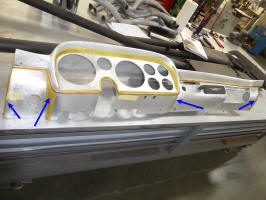Dash
I started working on the dash so I could get all of the interior wiring labeled and to be able to connect the battery and test the various electrical system.
Tony Nancy was the guy in So. California to use for re-doing interiors in his time. However, when I looked at this car, he was working on the dash. I couldn't understand why he was doing anything since the car was for sale, but after talking to him for a while I understood. Tony was suffering from Alzheimer's disease which my mother had also had, so I had a good understanding of his problems. Anyway, the work that he had done wasn't good nor was it correct. So I ended up stripping off the leather top.
I also carefully inspected the wood veneer that was on the lower portion. It's clear that it can't be saved. Now the issue will be do I replace it or paint it body color like most PF coupes are done. I asked both Pininfarina and Ferrari about the sun roof and veneer to try and figure out if they were original. Neither had any records specifying any special orders. I don't see any paint under the veneer as if the dash had been painted at some time though.
One thing rather amazing about this dash is that it is aluminum, consisting of several piece carefully welded together. If you look closely on the front side you can see the weld lines, but they are more visible on the inside.
As I was removing the chrome trim, I noticed that one of the T-shaped bolts was missing. This was pretty easy to make as I just took a standard 6mm bolt of the right length and ground the sides of the head off. Then I thinned the head down until it slipped into the slot.
Next I installed all of the gauges and started sorting out the interior wires and what gauge or switch they went to. I used a set of matching stick-on numbers to label each so I could easily re-connect everything in the future. I had to make one wire that was missing. Of course, it would be a black with white stripes that you can't buy easily. I ended up using a white wire and taped on a thin piece of black electrical tape to make it look right.
I'm about ready for a power on test. I'll pull all of the fuses and connect the battery and hopefully not finding any smoking wires. Then start putting in fuses one at a time while testing the circuits serviced by that fuse.
The dash quandryOne thing that was unique with this dash was the wood veneer that was glued where the normal PF Coupe dash would be painted the body color. This was in poor shape and looked pretty cheesy in my opinion, so I told Dennison to strip off the veneer and have it painted body color when the car was painted.
Then Butch Dennison pointed out that this dash had several extra chrome trim pieces that aren't on a painted PF Coupe dash. These are positioned to cover up the cut ends of the veneer. The blue arrows point them out. In addition, the glove box door and glove box opening have cast chrome surrounds.
All of this brings into question if the veneer was original, i.e. installed by Pininfarina when the car was made. Given the complexity of the cast glove box trim and the curved trim by the ends of the gauge binnacle, I am inclined to believer that the veneer was original. I doubt that someone would go to all of the extra work if they were adding the veneer after the car was made. However, neither Pininfarina nor Ferrari will confirm that the veneer was original.
If I don't put it back, the extra trim pieces would not look good on a painted dash.
_small.jpg)
